Do I Upload Cover and Text Separately for Copyright
It has never been easier to publish online or consume digital content. This comes with many advantages and can make teaching and learning and then much more targeted and impactful. Living in a digital world also brings upwardly many questions — ane issue that is very important to understand is copyright.
Whether you're an educator, student, or blogger, copyright is a topic that is often overlooked as it can be confusing or just non considered important.
Unfortunately, at that place are also a lot of myths about copyright circulating amongst the education community. Peradventure you've heard that you tin utilize whatever images or texts you lot find online if y'all're using them for education? Or perhaps you lot've heard that y'all can use any songs in your videos as long as you utilise less than 30 seconds? Yep, both not true.
Copyright is of import for all teachers, students, and bloggers to know about. And it doesn't have to be every bit complicated every bit you recollect. We're here to break down the basics of copyright and other related topics like fair use, public domain, and Creative Commons.
There'south a lot to learn in this post so recollect to bookmark it and employ the menu below to navigate.
Let's get started with the basics.
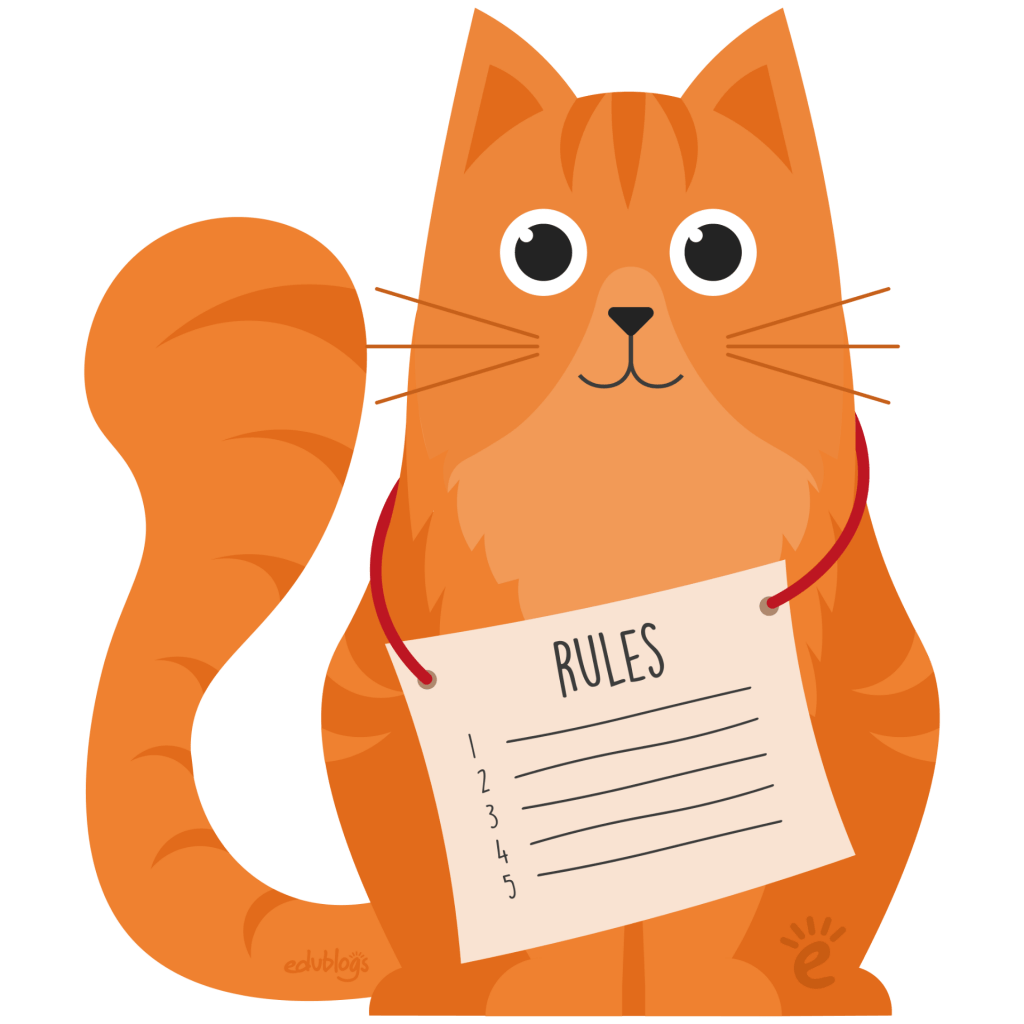
Copyright Rules To Remember
Permit's begin with the five principal rules you lot need to remember about copyright.
1) Simply because yous constitute information technology online, doesn't mean information technology'southward free to use (even if you're a teacher or student).
two) There are a lot of resource you can use freely including piece of work that has a Artistic Commons license or is in the public domain.
3) You have a right every bit a creator to accept your work protected from copying and you can also give your ain content a Creative Eatables license.
four) If in dubiousness about using content, ask the creator for permission, detect a free culling, make your ain material, or buy an culling that has the usage rights yous're after.
v) Instead of looking for loopholes, consider whether you're beingness the most responsible and upstanding digital citizen you tin can be.
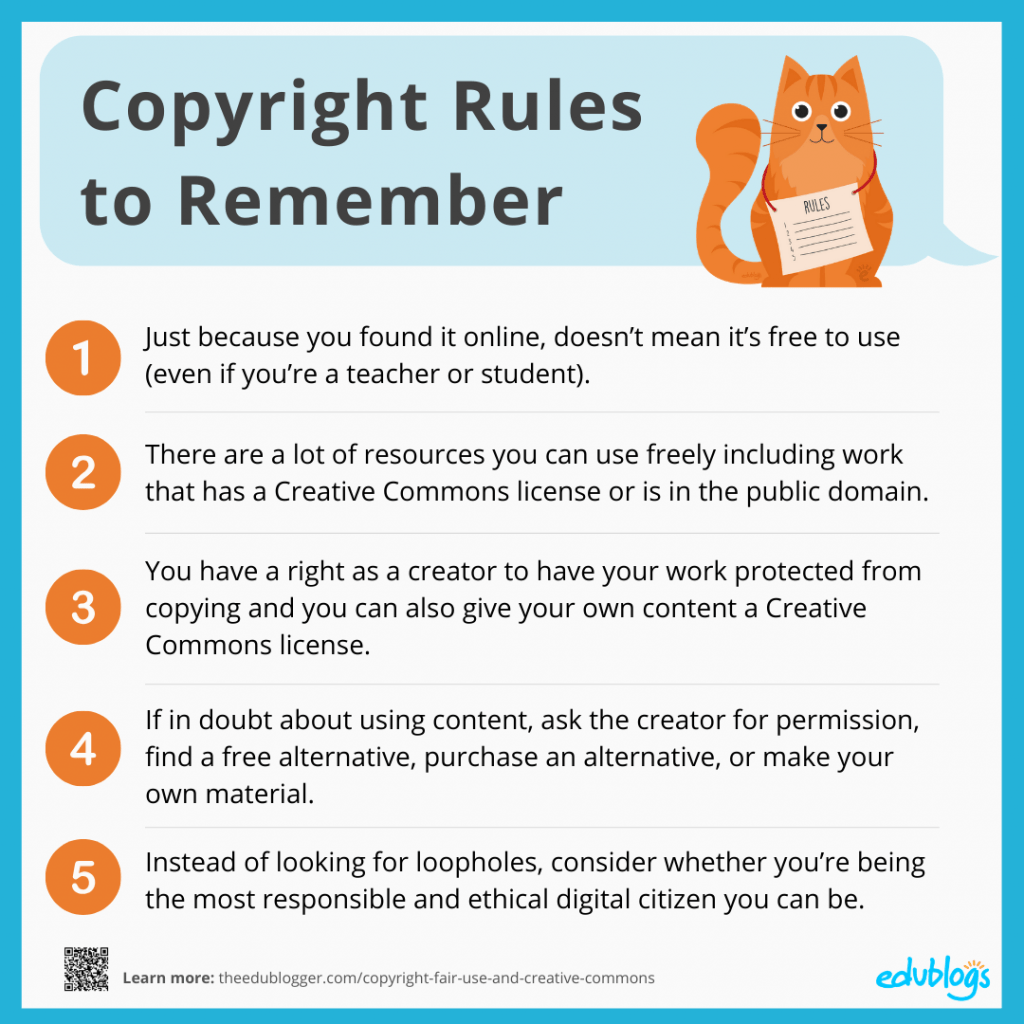
📌 Want a poster for your classroom or staffroom? Download a alphabetic character-sized poster of the v rules to remember here.
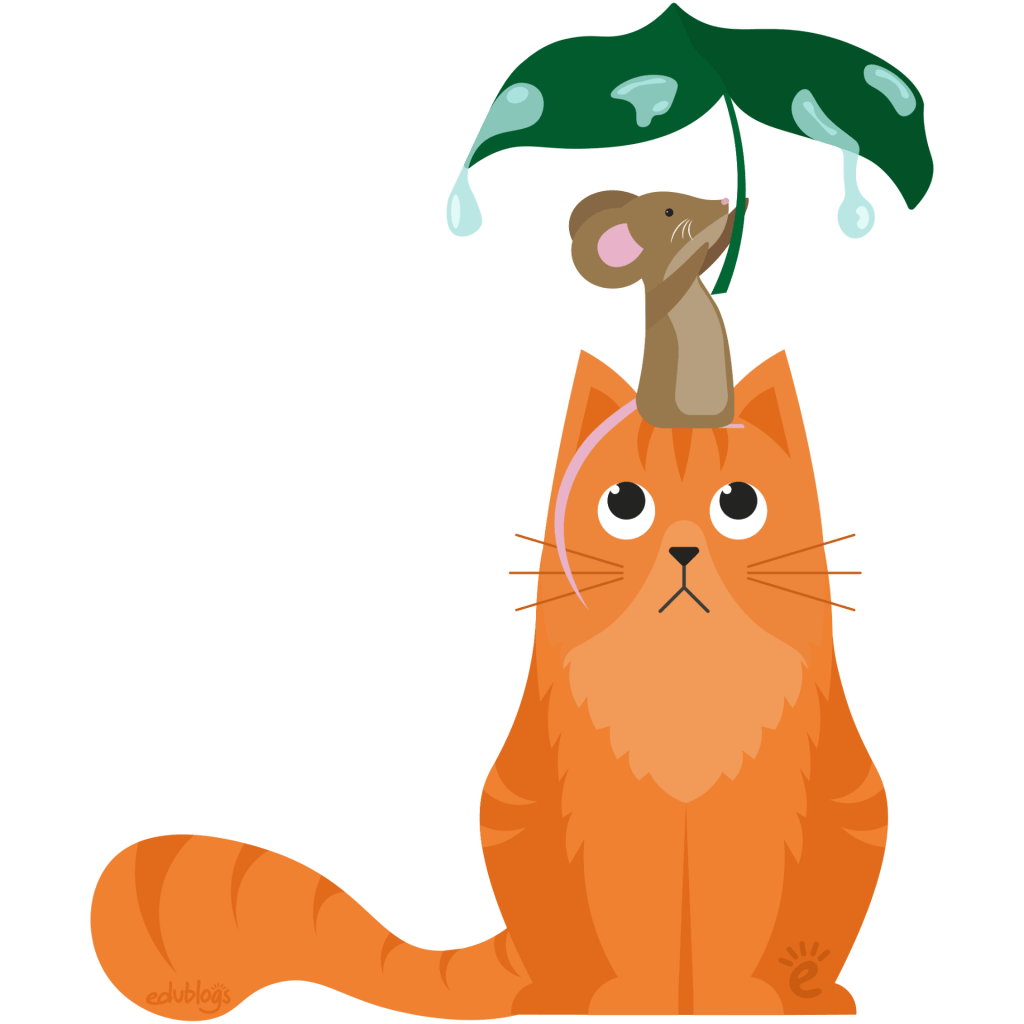
What Is Copyright?
Copyright is a class of legal protection offered to creators past default. That means, in many countries (like the Usa and Australia), you don't take to register your piece of work to have information technology protected by copyright.
Some creators practise register their work with the U.S. Copyright Office (or the equivalent in their own country). Ordinarily, this is to provide potent evidence to a court that the creator is the copyright holder if at that place is ever an infringement case. Yous don't need to have registered your work with the Copyright Office in gild to pursue a copyright infringement case.
It'due south a myth that y'all have to brandish a copyright symbol © to protect your work.
Can Others Utilise Your Copyrighted Piece of work?
If you lot're a copyright owner, someone else can't copy your work without your permission. They also tin't perform the work, distribute copies of the work, display the work publicly, or create derivatives.
If someone does utilize work that's protected by copyright without permission, that'south called copyright infringement. We'll cover this later.
Who Owns The Copyright?
Ordinarily, the creator of a work is the copyright possessor but the copyright can also be sold, traded, or inherited.
What Does Copyright Cover?
Copyright covers both published and unpublished works that are tangible in format. So, all tangible original piece of work is protected by copyright whether it's a web log post, music, artwork, photo, play, verse form, novel, dance choreography, movie, software, architecture, or more.
Copyright does non protect works that are not tangible, similar facts or ideas. Copyright merely protects the tangible expression of your ideas. And then you might have a great thought for a blog postal service almost teaching 5th grade math but unless you actually write the post, you can't protect the thought that's floating effectually in your caput. And you can't terminate others from writing most the same thought.
You can read more about the basics of copyright on the U.S. Copyright Function website (or on your ain country'south official site). There are some variations between countries.
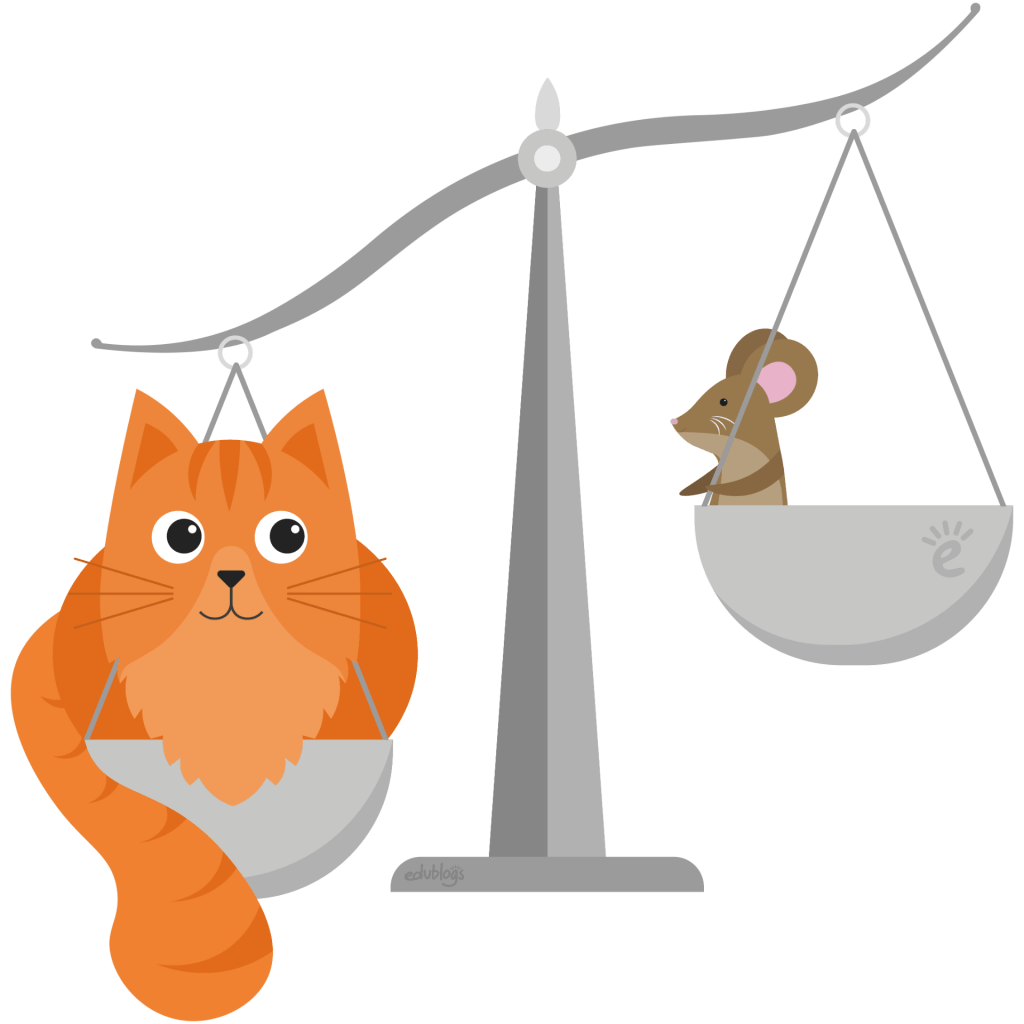
What Is Fair Use?
And so now you sympathize that nigh of the work you're accessing online or in books is going to be protected by copyright (images, text, videos, music, and more). This means you can't necessarily utilize these materials freely on your class blog, website, or with your students in your classroom.
"Merely off-white utilize applies hither doesn't information technology", I hear you inquire? Considering you're using images, text, videos, or music for educational purposes, that'southward okay, correct? Teachers and students don't accept to worry?
Non necessarily.
The more you lot dig in to the topic of off-white use, the more than you come to realize it is a gray area.
As the U.S. Copyright Office explains, The Classroom Utilize Exemption 17 U.S.C. §110(ane) allows you to use copyrighted cloth when you lot meet sure criteria.
For "fair use" to use, the copyrighted textile must be used:
- for performances or displays (e.grand. acting a play, reading poetry, watching a film, listening to music)
- equally role of confront-to-face up teaching activities
- in a nonprofit educational establishment
- in a classroom or similar place devoted to instruction
- using a lawful copy of the works (e.g. a motion picture y'all purchased legitimately)
If you're instruction online or wanting to hand out copies of work, then you may not be covered by this exemption. Furthermore, these fair use laws are specific to the U.S. so if you're in some other country, y'all may not be covered. Some countries don't have a fair utilize police or they may be more specific or broad than the U.Southward.
For example, in Australia, there is "Fair Dealing" which is an exception to copyright infringement that's a little more than specific than in the U.South. You may exist able to apply portions of copyright material without permission for the purpose of:
- research or report
- criticism or review
- parody or satire
- reporting news, or
- enabling a person with a disability to access the material
Overall, fair apply isn't as unproblematic as it seems, right? Instead of trying to observe loopholes with fair employ, a better approach is to look for materials that you lot tin can utilise freely.
The all-time identify to beginning is with public domain or Creative Commons materials. So allow's dig into that.
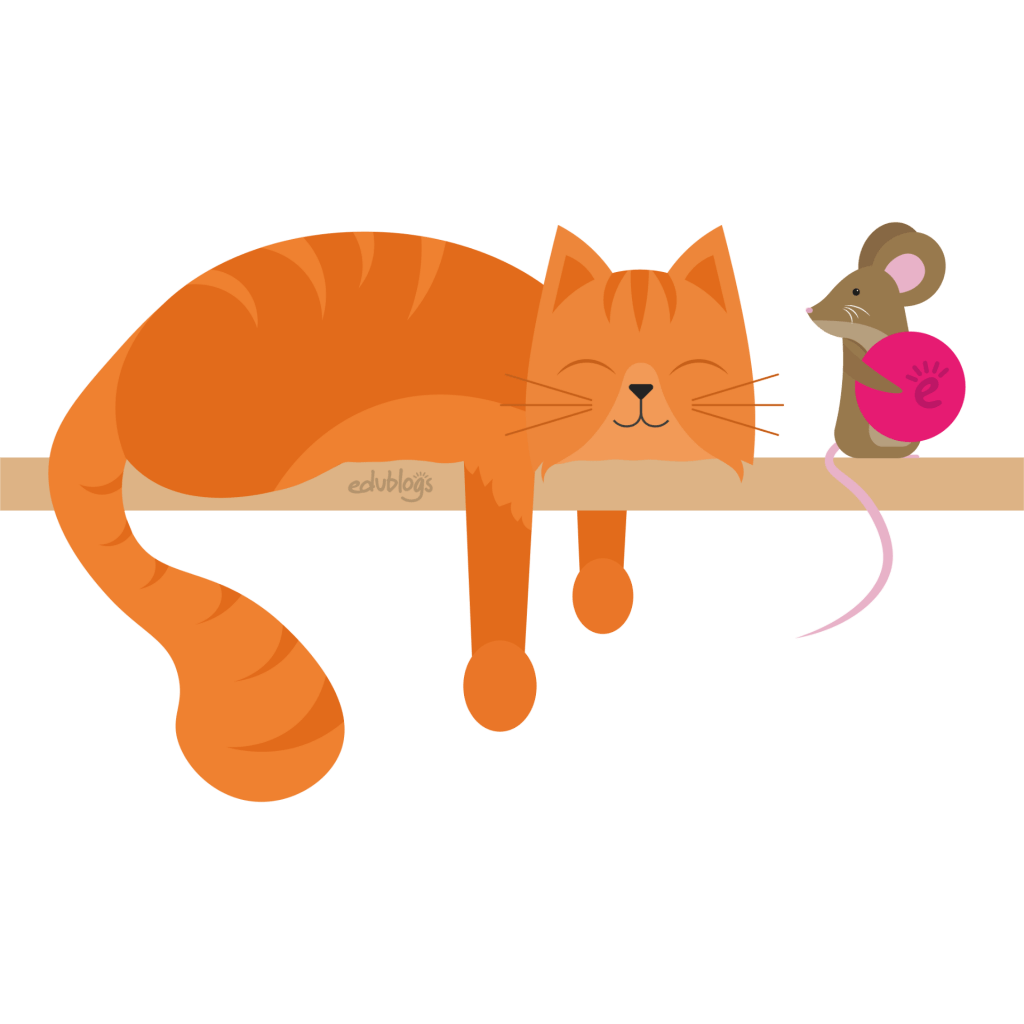
What Is The Public Domain?
In full general, in the U.S., copyright lasts for the life of the author plus seventy years later the author'due south decease.
What happens to work after the copyright expires? Well, it becomes part of the public domain. Works tin also enter the public domain if they are factual (due east.g. charts or calendars), they are published before a certain date, or a creator has assigned their work to the public domain.
When something is in the public domain information technology ways the work is owned past the public and you don't have to go permission to use information technology. This is great for educators looking for materials they can freely employ with their students.
Instance Public Domain Resources
There are many places online where you can find books, images, audio, and videos that are in the public domain.
Some popular choices for public domain materials include:
- Project Gutenberg: 60,000+ eBooks that tin exist downloaded (most are older works with expired copyright).
- Faded Folio: five,000+ eBooks that are in the public domain in Canada.
- Metropolitan Museum of Art: includes more than 400,000 images from The Met collection.
- Smithsonian Institution Public Domain Images: a drove of 3,000+ images housed on Flickr.
- Librivox: public domain audiobooks that are read by volunteers from around the world.
- Prelinger Athenaeum: thousands of public domain films (advert, educational, industrial, and amateur).
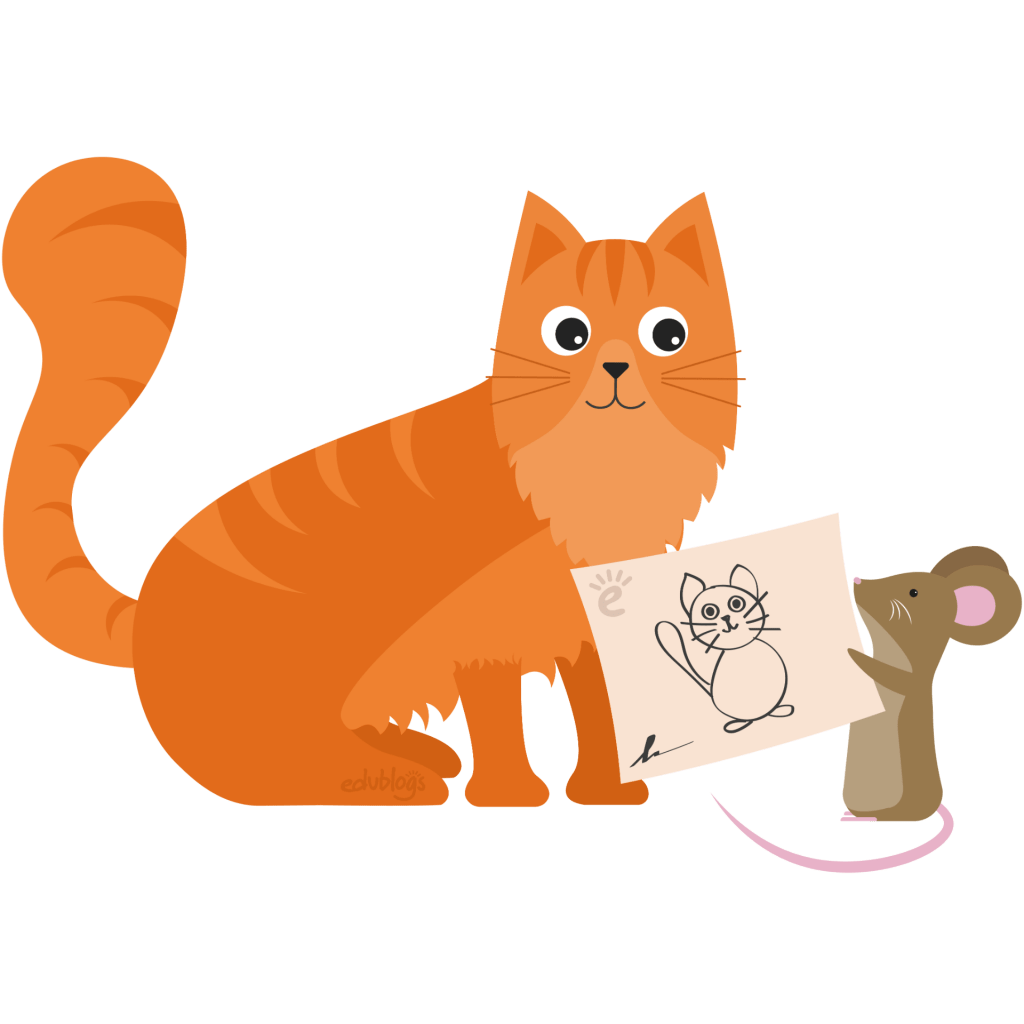
What Is Creative Eatables?
Sometimes creators (copyright holders) are happy for others to apply their work, as long as they meet certain atmospheric condition.
A creator can place a Creative Eatables license on their work which describes the terms of using, modifying, and sharing the works. A simple license removes the hassle of others having to enquire the creator for permission.
Creative Commons is an international organization that fabricated this system possible. The mission of the Creative Commons organization is clear,
By helping people and organizations share knowledge and creativity, nosotros aim to build a more equitable, accessible, and innovative world.
If a creator decides to attach a Artistic Commons license to their piece of work, there are six Creative Commons licenses to choose from.
I take written a mail on my ain blog almost copyright and Creative Commons that includes a poster to simplify the licenses.
The poster includes a Artistic Commons license so yous're welcome to use the affiche in your classroom or share information technology with your colleagues (a affiche near Artistic Commons licenses that includes a Creative Commons license — meta, right?). There is a PDF version of the affiche on my blog.
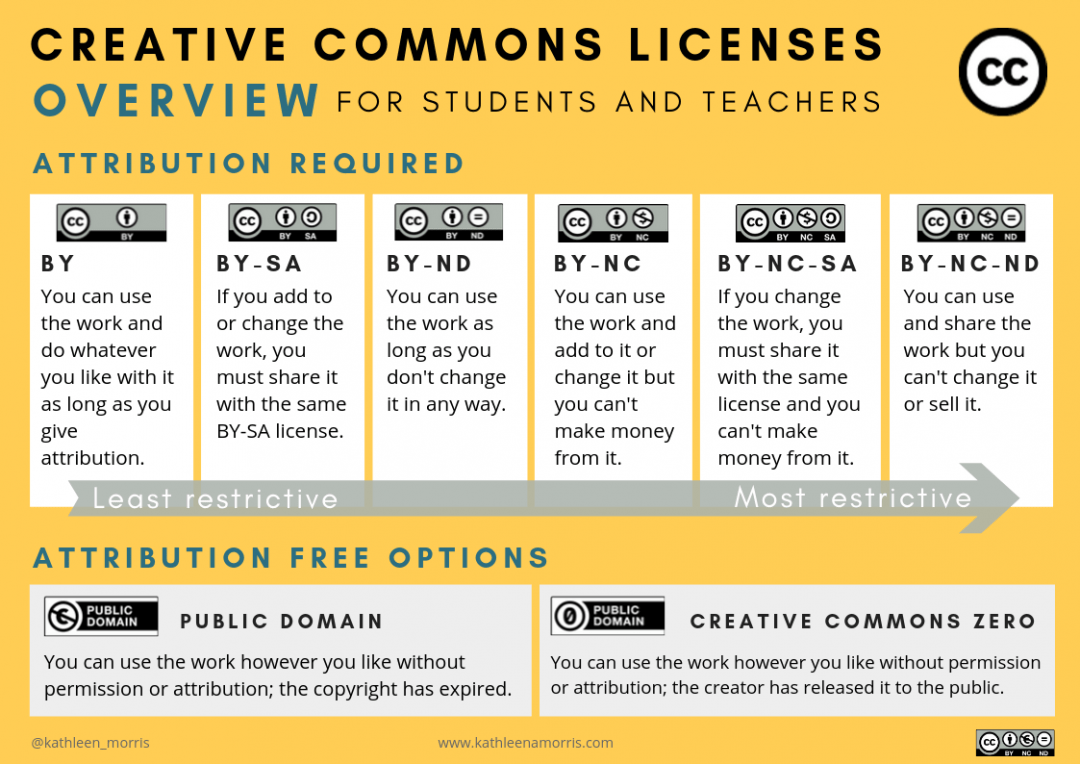
👉🏽 If you'd like to learn more than about Creative Commons licenses, the video below by McLaughlin Library is a expert place to start. You tin acquire more about Artistic Commons Licenses on the official website of the organization likewise.
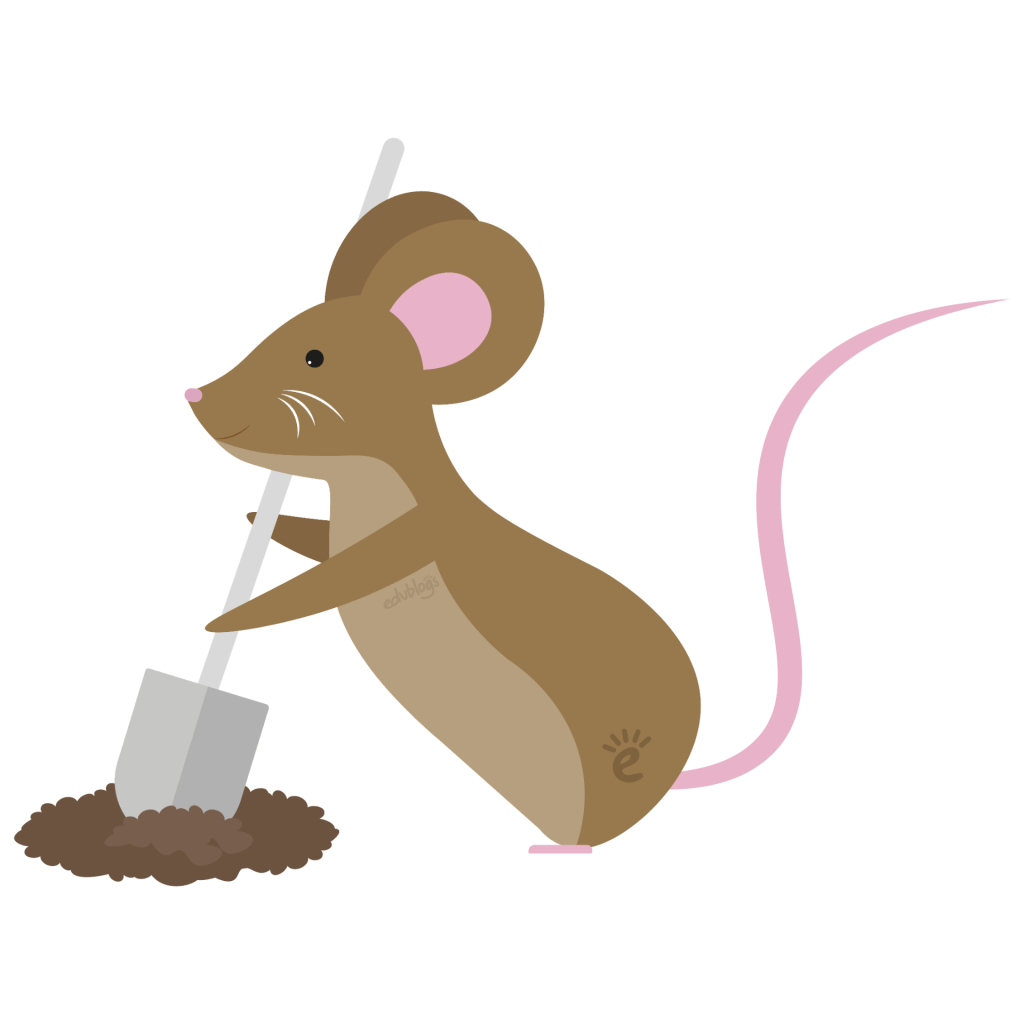
Finding Creative Commons Images
If you need images for your blog, website, videos, or other projects, Creative Commons images are a proficient choice. Every bit long as yous're using the paradigm according to the license with attribution, you won't be infringing copyright.
If y'all're looking for images that take a Creative Commons license, there are an increasing number of options out there. We'll show you some of the more popular options, simply first, information technology's of import to sympathise attribution.
All Creative Eatables resources require attribution unless they're licensed with the least restrictive Creative Eatables Cypher license. That means no attribution is required and you lot can use the resource however you like.
Allow's have a expect at how to attribute Creative Eatables images. The same instructions apply to other works (text, videos, etc.).
How To Aspect Artistic Commons Images
When you use a resource with a Artistic Commons license, you accept to attribute it in a particular way. Attributing means sharing the details of the work and giving credit.
The acronymTASL can help us recollect what to include.
- Title of the image or fabric (don't worry if there is no championship)
- Author or creator of the epitome/fabric
- Source of the image/material. Where is it from? Include a link if possible then others can notice it
- Fiftyicense — include which of the six Creative Commons licenses applies to the work
Here'southward a photo I found on Wikimedia Commons of a bridge in Western Australia. You can meet I included the attribution below the image.

If you employ images from Wikimedia Commons, getting the attribution information is easy. As yous go to download the epitome, you're prompted to re-create the attribution information.
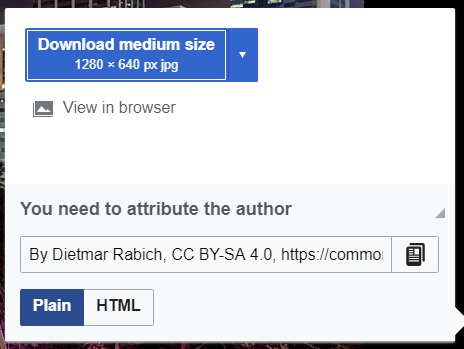
You can copy the attribution information either in evidently text format (equally in caption above), or as HTML as shown below.
By Dietmar Rabich, CC By-SA 4.0, Link
If y'all insert HTML into your web log mail, it'll become hyperlinked. Acquire more about inserting custom HTML in Edublogs/CampusPress/WordPress block editor here.
👉🏽 If you'd like to larn more than about attribution and explore some examples of ideal, adequate, and unacceptable attributions, check out this page on the Creative Eatables wiki. At that place'due south also a handy PDF about attribution on the Australian Creative Commons website.
Now you know the basics of attribution. Let's take a look at where you can find images and music that have a Creative Commons license. We'll begin with images that don't require attribution.
Creative Commons Zero Images
(No Attribution Required)
At that place are a number of websites where y'all can find images that are free to use without attribution (Artistic Commons Zero).
I've written a post on my weblog virtually the best websites to find Artistic Eatables images that either don't require attribution or the attribution is included inside the prototype similar the example below from Photos For Course:
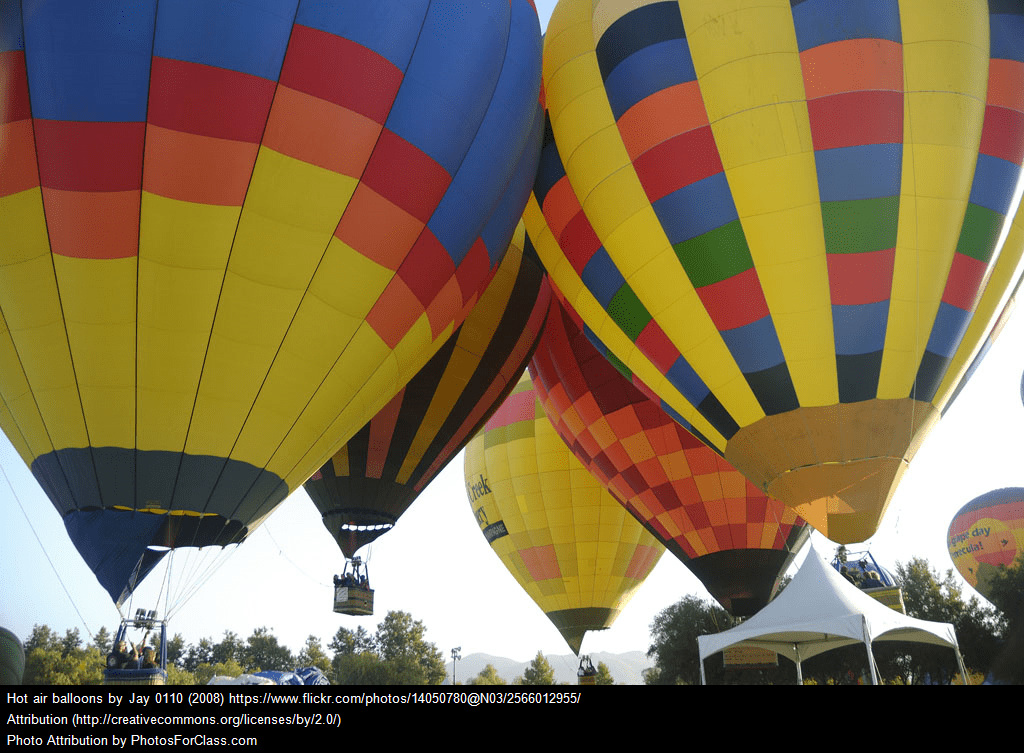
The sites reviewed in my post and the summary diagram below are:
- Pixabay
- Unsplash
- Pexels
- Photos for Form*
- Openclipart
- Pics4Learning
* Photos For Class currently has fewer options than it used to. The squad has told the states they aim to ameliorate this in mid-2020. 🤞🏽
Here's a summary poster that you're complimentary to use in your own teaching.
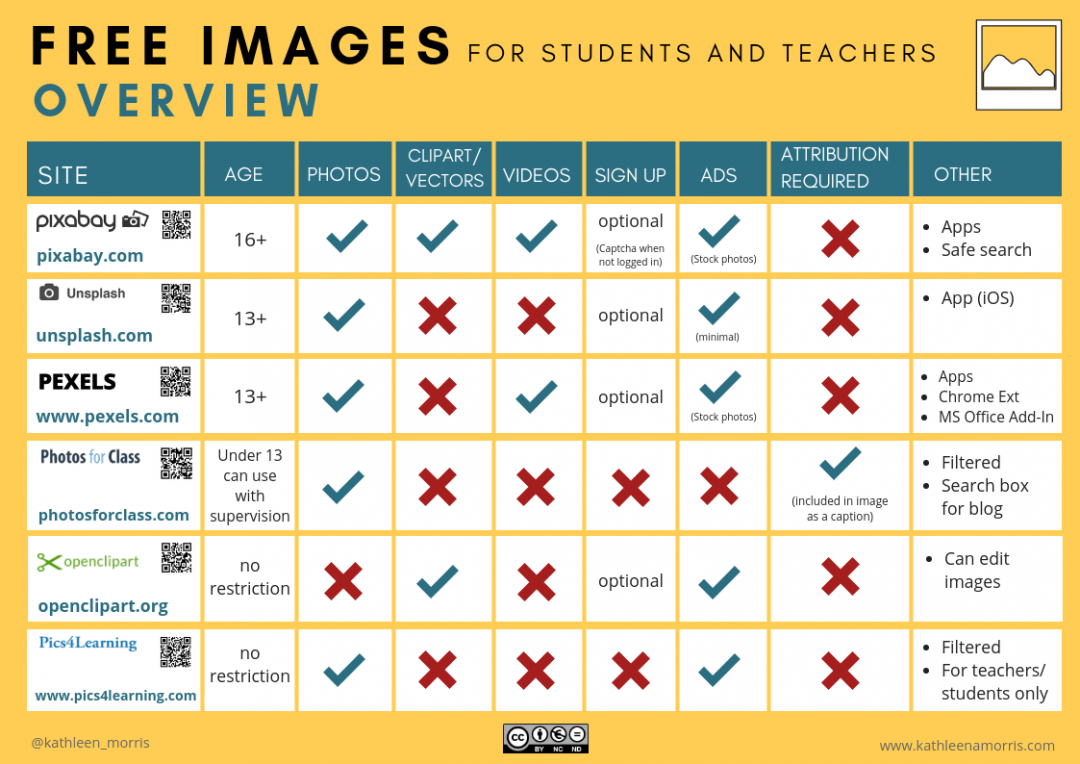
The one issue that a lot of educators overlook is that a lot of these free image sites are age-restricted. And so if you teach younger students, many sites are not going to be suitable.
Some other thing to consider is that even though the images from these sites don't need to be attributed (or they include the attribution information within the paradigm) it'due south still a good idea to teach students about copyright, Creative Commons, and attribution. As producers and consumers on the spider web, these are really vital understandings for students and all internet users. Just remember, even if attribution isn't required, information technology's always appreciated past the creator.
Creative Commons Images That Crave Attribution
Apart from the sites listed above with images that don't require attribution, there are other places to detect images with one of the six Creative Eatables licenses that do require attribution.
Creative Eatables Search Engine
The first place you might want to expect is the search engine on the official Creative Commons website. This is an excellent tool that was updated in 2019. It allows y'all to search through millions of CC images from more than twenty dissimilar sites.
When using the search engine, you tin can easily filter the search results — for example, you can filter by file type, utilise, or license.
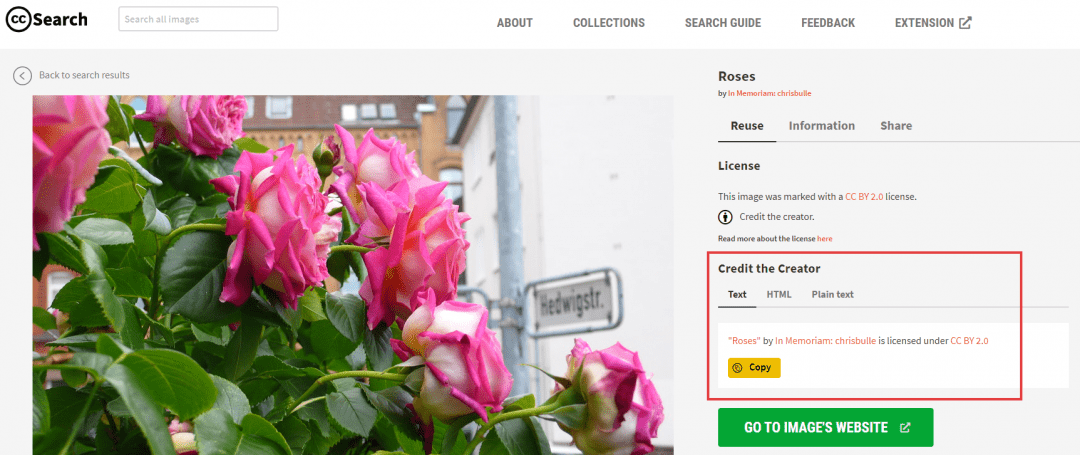
In that location's also a Creative Commons search browser extension that allows you to await for Creative Eatables images on the get.

Wikimedia Commons
We already mentioned Wikimedia Eatables above in the section about attribution. Wikimedia Commons has a big collection of images, audio, and videos that are free to use. Most require attribution.
Wikimedia Commons collections are included in the Creative Commons search engine so that tool really is a one-end shop.
Search For Artistic Commons Images On Google
Sadly, information technology is common practice for many teachers, students, and bloggers to take images directly from Google. Most images on Google are protected by copyright and using these images is illegal and unethical.
You may know that you tin can do an advanced search on Google to discover Artistic Commons images, although it does crave a few steps. First, you lot demand to filter your search results to find images that tin can be reused.
This video from Jurupa School Commune explains how to do that.
Then the next pace, that is not shown in the video, is yous have to click through to the site the prototype is from, expect for the Creative Commons license, and attribute your image correctly.
As we saw above, using the Creative Commons search engine or Wikimedia Commons makes information technology actually simple to attribute your chosen epitome. All y'all really take to exercise is copy/paste. Using Google search doesn't get in like shooting fish in a barrel to attribute Creative Commons images. So this is not the way we'd recommend finding Artistic Commons images online.
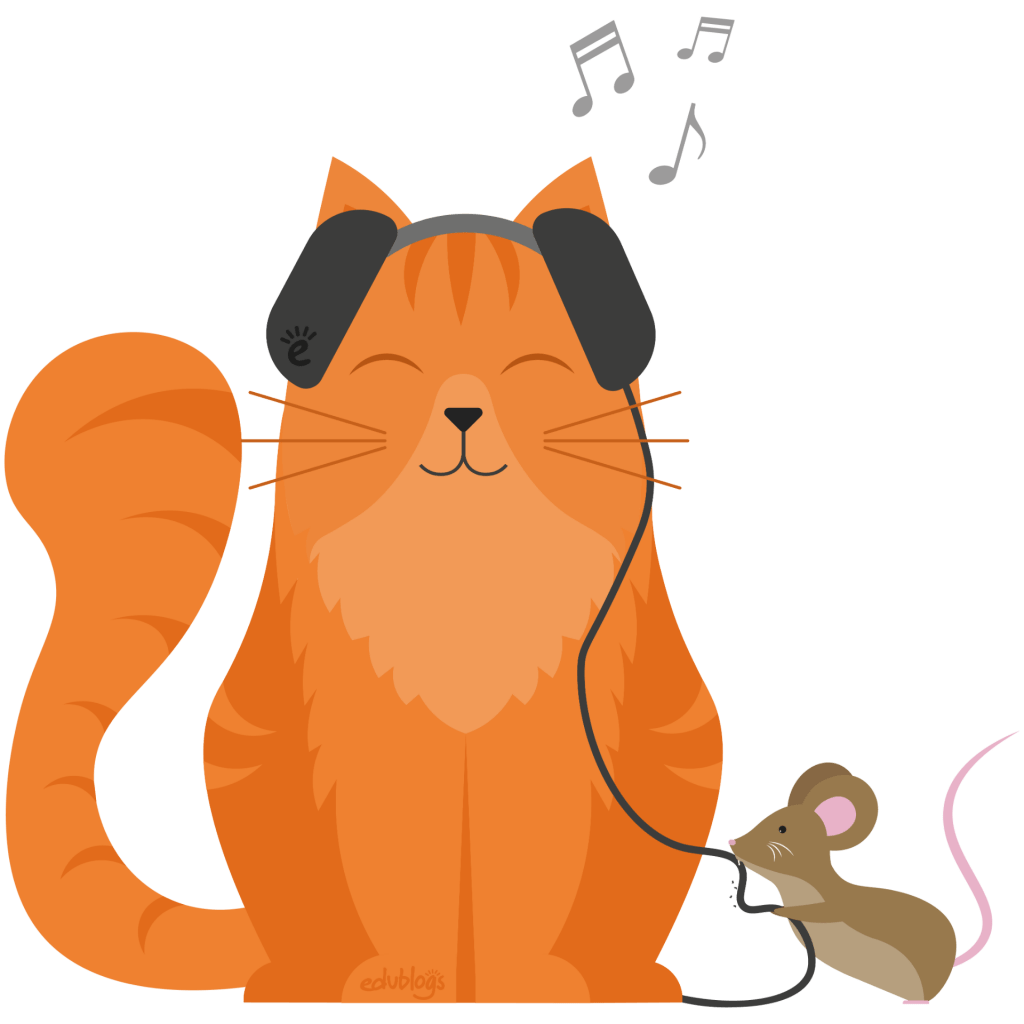
Copyright And Music
No doubt there have been many times when you want to utilise music on your blog, in your content, or in class. When you're creating a video information technology can be extremely tempting to use pop music that reflects the mood and emotion of the footage. Or maybe you desire students to play popular music at a performance or public event.
As y'all probably know, most music is protected past copyright. It doesn't matter if you paid for a song or not, it's nevertheless protected by copyright. It doesn't matter if you're only using thirty seconds or less of a song, it's still protected by copyright.
Allow'due south have a look at some specific examples of music and copyright.
Using Music In Projects Like Videos
Normally, you lot can't just use any music you lot like in your projects or videos.
Withal, in many countries, there are exceptions. For instance, in the U.S. and Australia, y'all are allowed to re-create music to add together to a video if:
a) it's for educational purposesand
b) you're not sharing your video publicly (or selling information technology!)
Then, if you make a video with music that'due south protected by copyright, it'south not okay to publish this on a public blog, social media, YouTube, and so on. And yous couldn't evidence your video at a public event. Yet, information technology's okay if the video is just being shownprivatelyto teachers, students, and families at home/school.
It's also of import to note that background music is not considered "educational utilize".
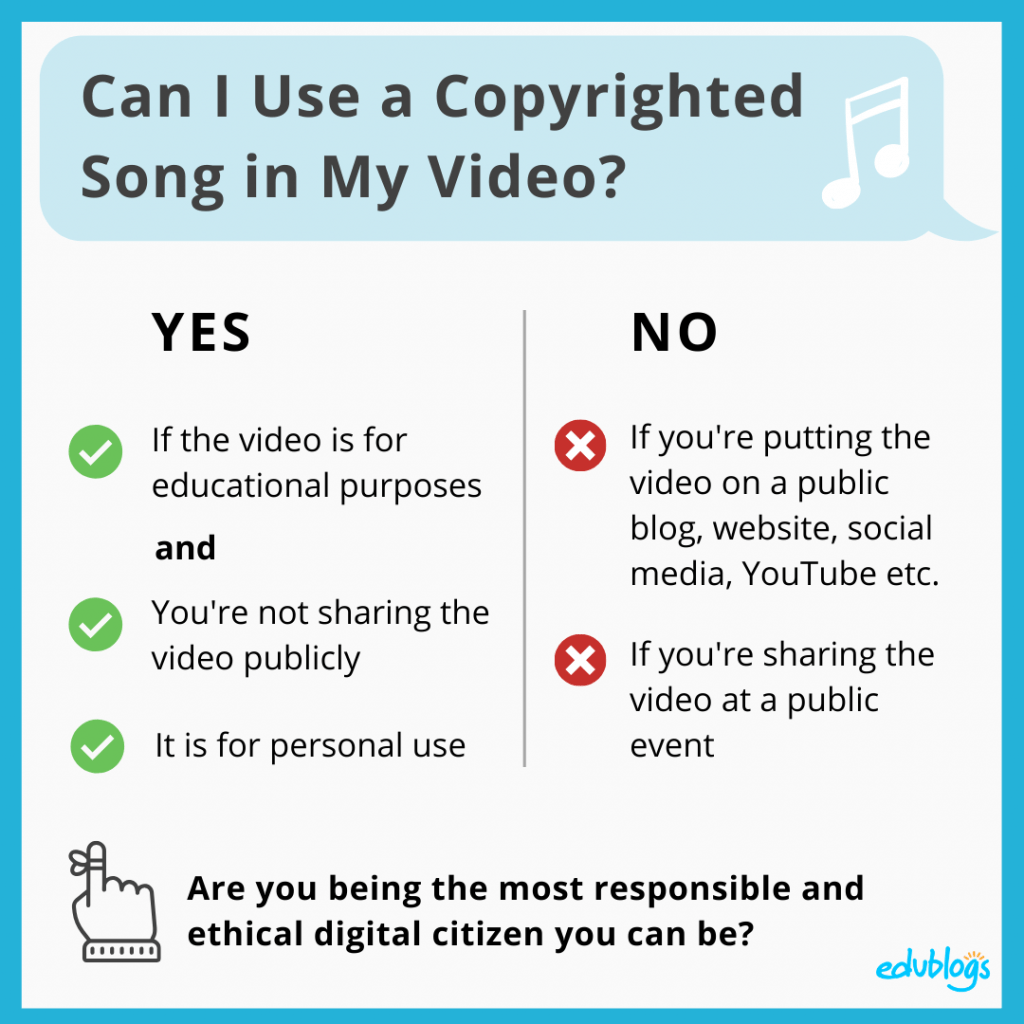
Paying For Music And Streaming
There are popular sites and apps where you lot can pay to download or stream music legally — for example, Apple Music, Google Play Music, and Spotify.
You can heed to your downloaded music yourself, only tin can't upload the music to your web log or to a video or other project you're working on.
It's fine to stream music videos on sites like YouTube too merely information technology's not normally legal to download the sound from a YouTube video as explained in this article.
Also, streaming music is meant for personal use — not for a public broadcast.
As Spotify says,
…it'southward not possible to use Spotify in public places (such every bit bars, restaurants, stores, schools, etc.). Yous may only make personal, non-commercial, entertainment use of the content.
Most streaming services are like.
Embedding Music Videos
Embedding a music video from a site like YouTube or Vimeo into your weblog is usually immune.
As Richard Byrne says,
If the host provides an embed and you embed it using their code according to their rules (unremarkably that ways not trying to hide branding), you lot can embed it without violating copyright.
You can as well link to music files or videos that are publicly available on the spider web.
Using Purchased CDs
Some people even so heed to music by buying a CD or borrowing one from the library, although, of class, digital music is condign a lot more than popular than CDs in many parts of the globe.
Again, you can't re-create the music from a CD and use it for another public projection (east.one thousand. upload it to your blog or add it to a public video). It doesn't matter if you lot have purchased the CD legitimately.
👉🏽 If you lot'd like to learn more than most using music in education for other purposes including school concerts and online learning, check out this fact sheet from the National Association of Music Teaching.
Creative Commons Or Copyright Free Music
Even though most music out there is protected by copyright, there are many places online to find Creative Eatables or other copyright free music options.
Y'all might start like to check if your district has any subscriptions you lot can make the about of. For example, Soundzabound.
If this isn't an option, there are lots of other sources of gratuitous music online.
Three options for free music and audio are:
- Dig CC Mixter
- YouTube Audio Library
- BBC Sound Furnishings
Let's take a look at how these 3 sites piece of work.
Dig CC Mixter
Dig CC Mixter offers thousands of hours of free music.
The music on this site has different Creative Eatables licenses and then you lot demand to check whether y'all need to attribute the music or not.
Educational Blogger Richard Byrne explains in a video how to utilize Dig CC Mixter and filter past license.
YouTube Audio Library
YouTube has a dandy library of music you tin use. Visit the Audio Library on YouTube to browse the selections.
If you click on Attribution, you tin can filter your results to find music that does or doesn't crave attribution.
You tin preview the music to encounter what information technology sounds like and download the music you lot want to employ.
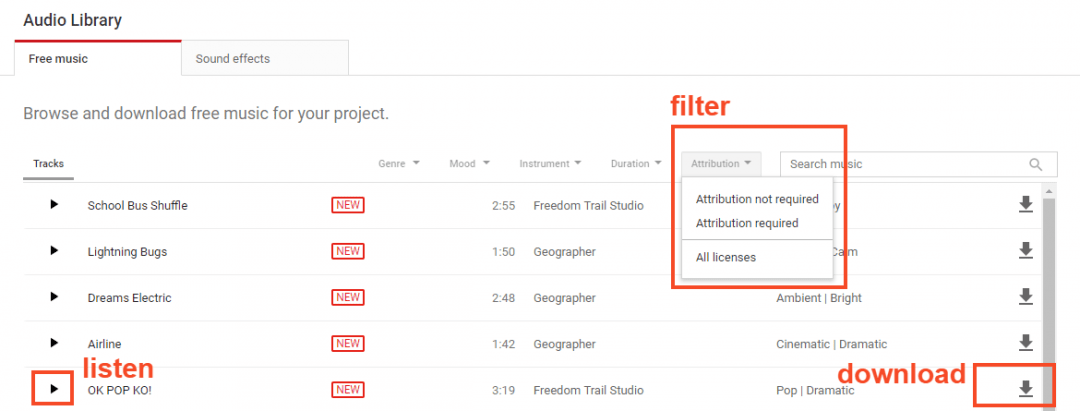
Here's an case called Sunshine in my Center by Jingle Punks.
BBC Sound Effects
During 2018, the BBC fabricated over 16,000 sound effects available to use. These sound effects are non actually Creative Commons — they're protected by copyright but the BBC gives permission for the audio effects exist used for personal, educational, or research purposes.
You lot can scan by category to find the sort of sound effect you're after for your projection.
You should put a link in your project or blog mail to say that your sound furnishings are from the BBC and link to their site.
Here is an instance of a sound clip. This is the sound of the surf at Bondi Beach, Sydney, Australia.
Surf – Bondi Embankment, bbc.co.uk, copyright 2020
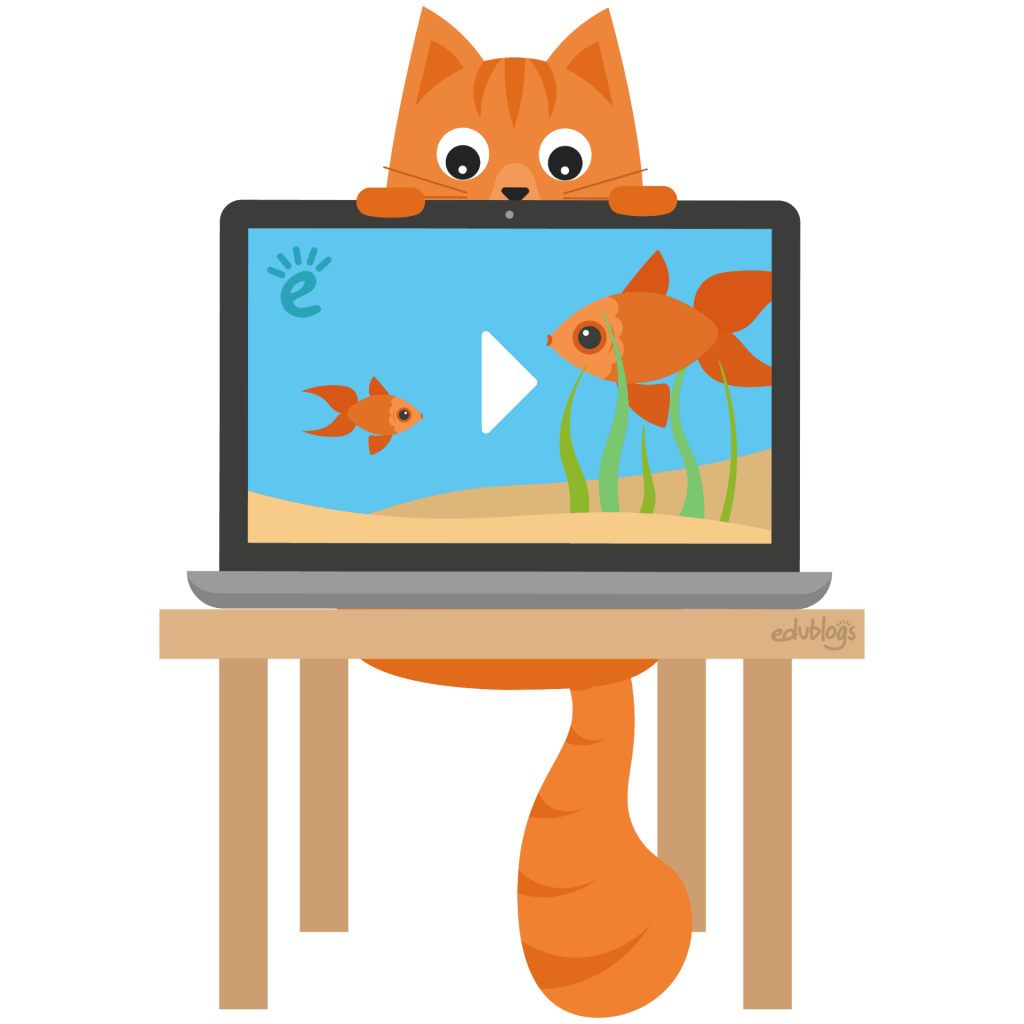
Copyright And Videos
Where would we be without all the crawly video content we at present have at our fingertips on the spider web? In the educational activity globe, extensive video libraries similar YouTube are condign priceless.
Video copyright can be complicated as video can draw together multiple elements — video footage, images, music, audio effects, and so on. When using, sharing, or creating video, you need to make certain all of these elements are non protected by copyright.
Tin You Link Or Embed Videos?
You are free to embed any video from sites like YouTube, Vimeo,TeacherTube, TedED etc. on your web log or website as long as it gives y'all the embed option. It's a good idea to add a link to the video likewise.
Linking or embedding from YouTube or other sites on the spider web is not considered copying. Just brand sure the videos aren't violating copyright. If they are, they'll probably exist taken down past the site somewhen but some content gets through.
Can You Download Videos From Sites Similar YouTube?
While linking and embedding videos is okay, yous shouldn't download videos from YouTube. Sometimes this is tempting for teachers especially if they accept unreliable internet connectivity, they're worried well-nigh a video existence removed in time to come, or they want to add a video to a learning management organisation. However, downloading videos raises many legal questions and by and large violates copyright.
Additionally, you lot tin't necessarily utilise parts of videos from YouTube (or other sources) to make mashups or remixes. If you want to cut or remix videos, information technology is meliorate to use Creative Eatables content, public domain content, or request permission from the copyright holder.
Uploading Your Ain Videos To YouTube
If yous want to upload your videos to a site like YouTube call up to respect copyright. You should only upload videos that y'all made or that you have permission to upload. Brand sure there aren't copyrighted elements (due east.thousand. music or images) in your videos. Of course, go permission from your school or district if these videos are beingness used professionally.
Educators should exist especially careful near permission if using footage of students. Some teachers use the blurring tools bachelor in YouTube to mistiness student faces and identifying objects. Richard Byrne shares a sit-in of how to do this on his website.
👉🏽 If you're a creator and would like to larn more than well-nigh videos and copyright, YouTube has a useful playlist of eight videos on their YouTube Creators channel.
Showing Videos To Students
Teachers can show videos in class for educational reasons, such as videos legally uploaded to YouTube (however, some districts don't allow YouTube to be used in schools).
If yous have a legitimate copy of an offline video (eastward.g. DVD), you're allowed to utilise this in course for face-to-face instruction every bit long as it'south for educational purposes (not for amusement or a reward).
Recall, this would be in line with the U.S. off-white use policies we described above, then check your own country's guidelines if in dubiousness. If y'all're in Australia, a useful website for all things copyright is https://www.smartcopying.edu.au

Copyright And Text Or Curriculum Materials
Say you lot've purchased a textbook or other education materials. Y'all can obviously utilise these materials in class and you might be able to make photocopies, still, in most cases you lot can't upload purchased curriculum or books to a public site. That means don't put scans, photos, or PDFs of textbooks, worksheets, posters, picture books, novels, or other learning materials on your public blog or website.
If in dubiety, seek guidance from the visitor y'all purchased the curriculum materials from well-nigh reuse.
Marketplaces Like Teachers Pay Teachers
Non and so long ago, we were all purchasing our curriculum materials from professional organizations. At present anyone can exist a creator and with the rising of sites like Teachers Pay Teachers, new copyright questions have arisen. As Education Week has pointed out, copyright infringement is rife on this popular marketplace.
What does this mean for you lot? Well, if you're uploading to a site similar Teachers Pay Teachers yous need to make sure you have permission to apply all your elements including fonts and images.
If yous're downloading resources from Teachers Pay Teachers, you demand to seek clarification about how these tin be used. And as well proceed an eye out for resources that look like they could be violating copyright earlier you use them (e.chiliad. copies of a published textbook). In that location is limited vetting of copyright materials on Teachers Pay Teachers. As a savvy internet user, we all demand to have an sensation of the larger copyright traps that are out there.
Link To Curriculum Resources
Linking may be a useful culling to copying curriculum materials. If 3rd-political party text, manufactures, or other content is bachelor on the web, teachers or students could include a link to the content on their blog or website.
Like embedding, linking is not a copyright activity considering you're non "copying" the content. Y'all're just providing a path to the original location that the readers can access themselves.
Creative Commons Textbooks And Curriculum
Another choice to avoid copyright violations is to use curriculum materials that have Creative Commons licenses. One case is OpenStax. Y'all can browse to find textbooks for a range of topics and the materials are gratis to use nevertheless you see fit.
Y'all'll find some more open textbooks and course materials listed on this Open up Washington page.

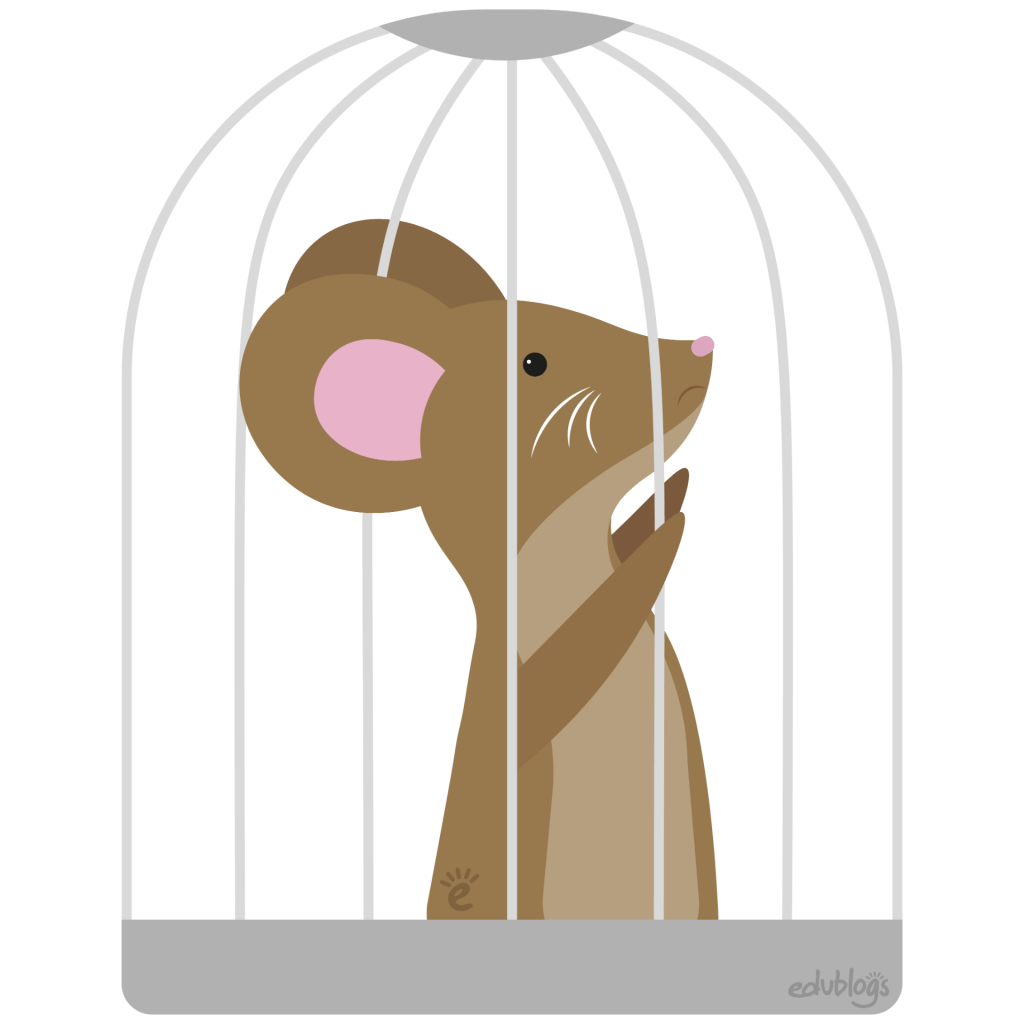
Copyright Infringement
We know that about images, text, music, and other content are protected past copyright by default. Using work protected by copyright without permission is called copyright infringement. This is unethical and illegal. "Using" the work might involve reproducing, displaying, distributing, performing, or making your own derivatives.
But I Won't Exist Caught…
If merely that were true.
Google makes it incredibly easy for companies and content creators to seek out those posting their piece of work on the spider web. In fact, most large companies now aggressively patrol the internet looking for copyright infringement.
Sadly, nosotros are also noticing more and more than "constabulary firms" and organizations out there looking for copyrighted content every bit a way of generating business. They and then contact the copyright holder offering their services to get the content removed (for a fee of form). It is a ruthless (and apparently profitable) practice.
Another issue that is important to exist aware of involves Creative Commons Naught sites. There have been cases where people have used images from costless image sites like Unsplash and then were hit with a copyright infringement case. Sometimes people put images up on these sites in order to sue. They exit the images upwards on the site until they are downloaded multiple times and so remove them. This is a dark side of Creative Commons Zero that's important to be aware of.
What If I Am Defenseless?
In many countries, copyright infringement brings hefty penalties including fines of hundreds of thousands of dollars and imprisonment, depending on the situation.
Of course, a good offense is your all-time defence force. Cheque your blogs and grade websites for whatever potentially offending material. Has anyone uploaded images straight from other websites or Google? Are at that place are educational materials (e.thou. copies of textbooks) that shouldn't exist there? Has copyrighted music been used publicly? If you find annihilation, only remove it.
The law requires copyright holders to requite y'all (and the host of your site, such as Edublogs, WordPress, etc.) an official notification. Take these seriously and act speedily to remove what they desire if you are in the incorrect. That should be the cease of it.
Hither at Edublogs and CampusPress, we're contacted most copyrighted materials regularly. These are mostly images from Google, curriculum documents, or PDFs (due east.k. textbooks or sheet music), or music files.
Nosotros were once notified near a teacher with a blog on Edublogs that had a harmless earth map epitome on his blog that he had presumably found using Google prototype search. When we contacted him telling him why we had removed the image, he asked if he and his students could write an amends letter to the copyright holder.
It was excellent – turning what could be a bit of an embarrassing mistake into a teachable moment for his students. Now this teacher had a good reason to discuss copyright and Creative Commons with his students.
Even if you haven't washed anything wrong, having a space to publish online like a blog or website is one of the all-time means students tin acquire most copyright and Creative Commons.
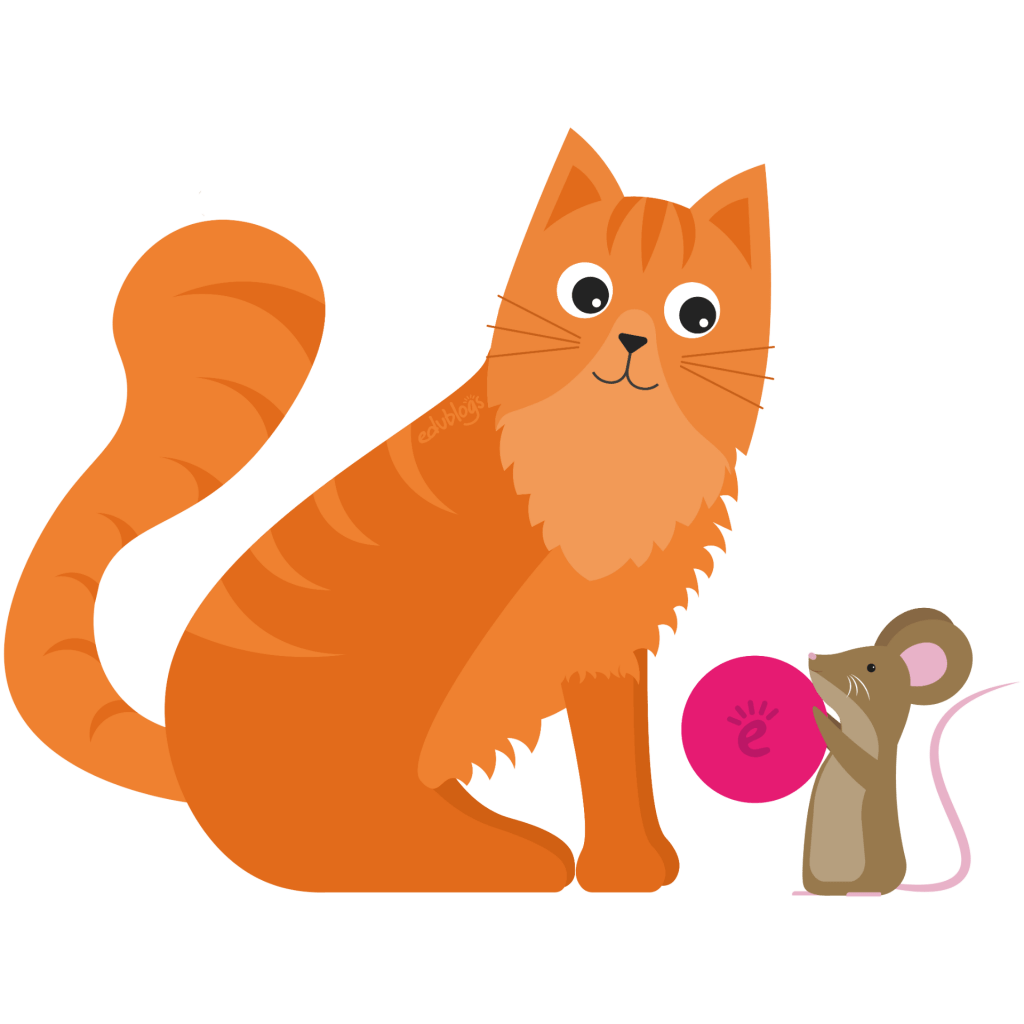
Copyright Considerations When Publishing Online
Whether you're a teacher, a educatee, or a regular blogger, when you lot're publishing online you must do your best to be a responsible digital citizen. This means respecting others' work and respecting copyright.
Here are three key things to retrieve when publishing online to be a legal and ethical digital citizen:
1) Steer Clear Of Google Images
Don't re-create images off Google or other websites. Even if you lot include an attribution information technology is still illegal and unethical.
If yous like an epitome and don't know where information technology originally came from, a opposite search might assist.
If an prototype is created by someone that y'all can contact, you could always ask their permission to use it.
Remember the all-time bet is to find Creative Eatables or public domain images. Otherwise, take/brand your own images or purchase some from a stock photography website.
2) Embed Or Link To Sound Or Video Clips
If you lot're going to include a video or an audio clip, embed the file from the source and include a link too. Don't download audio or video files as this brings up many questions about copyright.
If yous're embedding from a site like YouTube, make sure the content doesn't violate copyright law. YouTube is commonly pretty good at cracking downward on this but there is some content on at that place that does violate copyright — east.thousand. copies of television shows.
iii) Never Re-create Someone Else'south Blog Post
You lot might find this a little hard to believe but unfortunately people re-create posts from other blogs and publish them on their own site all the time. Or they publish the blog post in another format such every bit a PDF document or slideshow.
And in case you're wondering, copying someone's web log post and then including an attribution does not brand this okay.
If you practice want to share someone else'southward blog post on your own blog, consider writing a short description of the mail service on your blog and so inviting readers to click on a link to read the post themselves. In your ain post, you could include some key points almost what you agreed or disagreed with. Or maybe you can expand on the topic in a different management. All this would exist perfectly acceptable and no doubt the writer would appreciate the interaction.
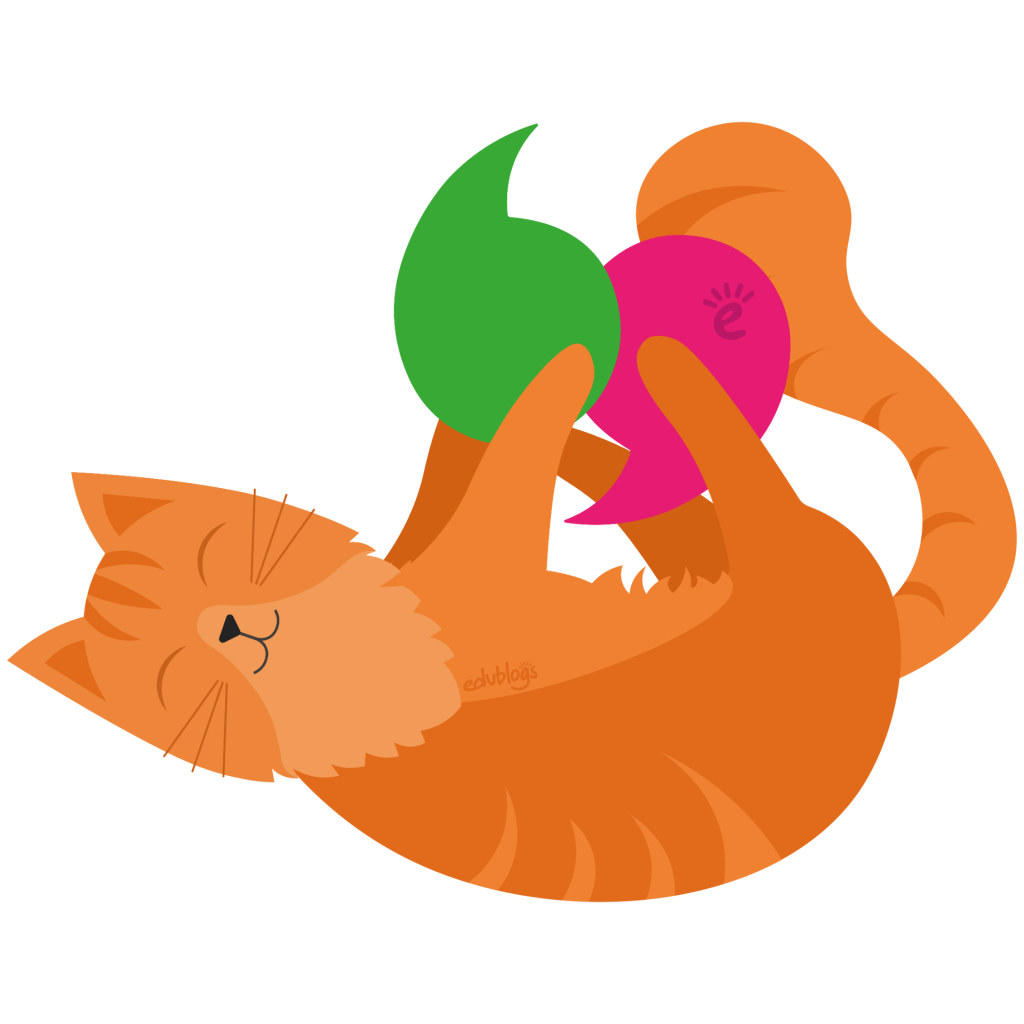
Using Quotes In Blog Posts
Hopefully you at present know that you definitely can't re-create and paste someone else'southward whole blog mail service or image, but yous can include a quote of some text.
Here are a few points to exist aware of that nosotros included in our post on The Edublogger about quotes:
- Make it obvious which words are your own, and which words belong to someone else by using quotation marks or block quotes.
- Make your quotes brief. There are no universal rules here. Some larger organizations have guidelines around how much y'all tin can quote (due east.g. Hubspot's rules are 75 words). If y'all're unsure or think y'all might exist using also much of someone'southward article, contact them to inquire permission. Never re-create the whole post.
- Always include the person'due south name, and link to their site, article, or volume if you tin can.
- If yous're using blockquotes, the attribution could be before the quote, within it, or below it.
- If you shorten a quote, use an ellipsis (…) in place of the missing words.
- If you're adding any words or corrections to the quote, apply brackets.
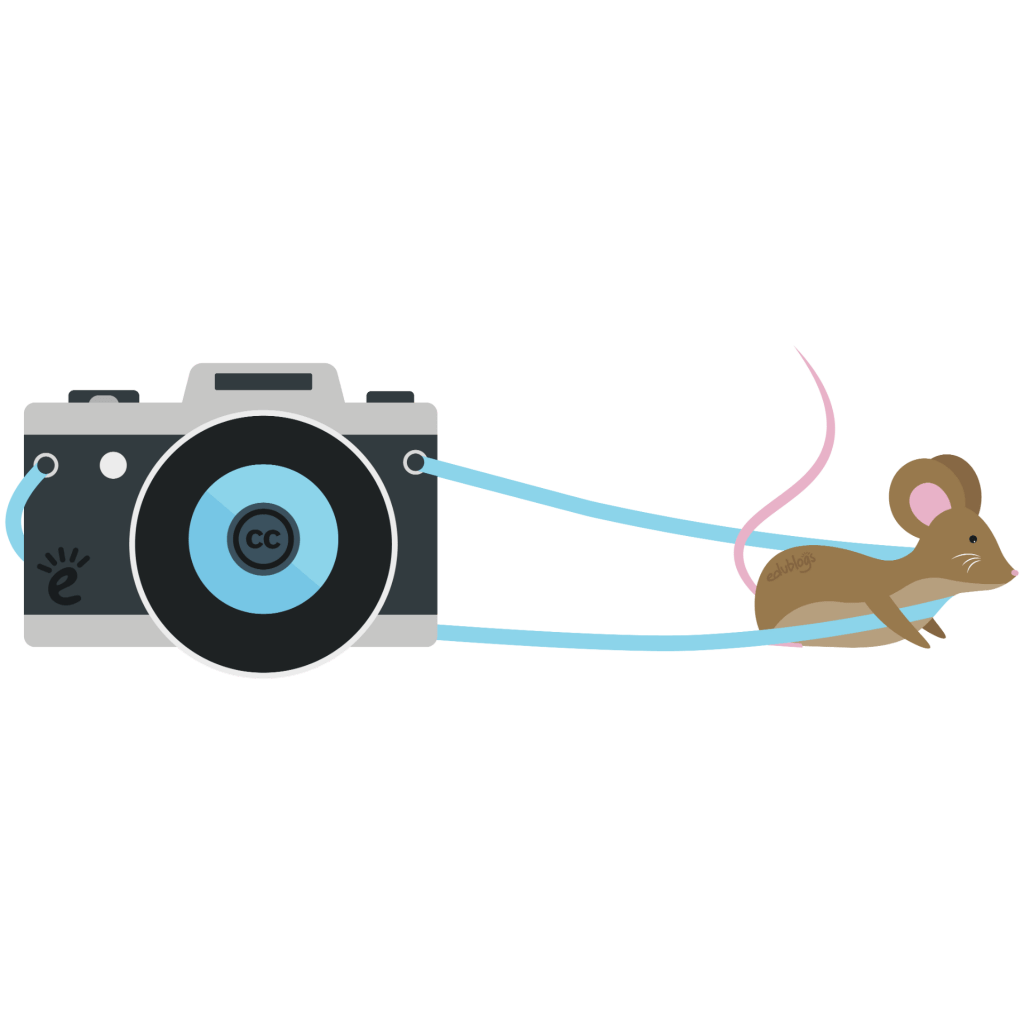
Adding Your Own Artistic Eatables License To Your Work
Earlier, we looked at the vi types of Artistic Eatables licenses available to creators. If you're publishing online, you're a creator too! And you don't have to be a professional. Perchance you share memes or lesson resources on social media? Perhaps you write web log posts? Perchance you take your own photographs that you share online?
Accept you ever considered adding a Creative Commons license to your own original work?
Every bit the Creative Commons organization explains,
When you utilize a CC license, you give permission to anyone to use your material for the full duration of applicable copyright and similar rights.
This is therefore a serious decision but an important one. You can contribute to edifice a collection of fine art and cognition that's accessible to anyone in the earth. How absurd is that! You remain in control by choosing your own license, and people who similar your work can apply or share information technology without having to contact you for permission.
Earlier you cull a Creative Commons license, you demand to brand sure you are the copyright owner and the piece of work is copyrightable (eastward.thousand. in a tangible format).
If you're unsure which license to choose for your own work, there is an interactive tool on the Creative Eatables website. This tool suggests a license after you answer a few questions. It likewise gives yous a CC button that yous can attach to your piece of work to display your license.
If yous would similar to display your creative commons license on your web log, the easiest way is to use a text widget in your sidebar.
From your dashboard, go to Appearance > Widgets and select a Text widget to add to your sidebar. Paste the code provided by your Creative Eatables license provider in the widget's text box, and click "Save".
Adults aren't the merely ones who can add Artistic Commons licenses to their work. In many countries, children tin too. What an authentic way for students to learn about copyright and sharing online.
Perhaps a whole course or schoolhouse could make a library of Artistic Commons content (east.g. images or music) that tin be used freely by the education customs? Talk about authentic learning!
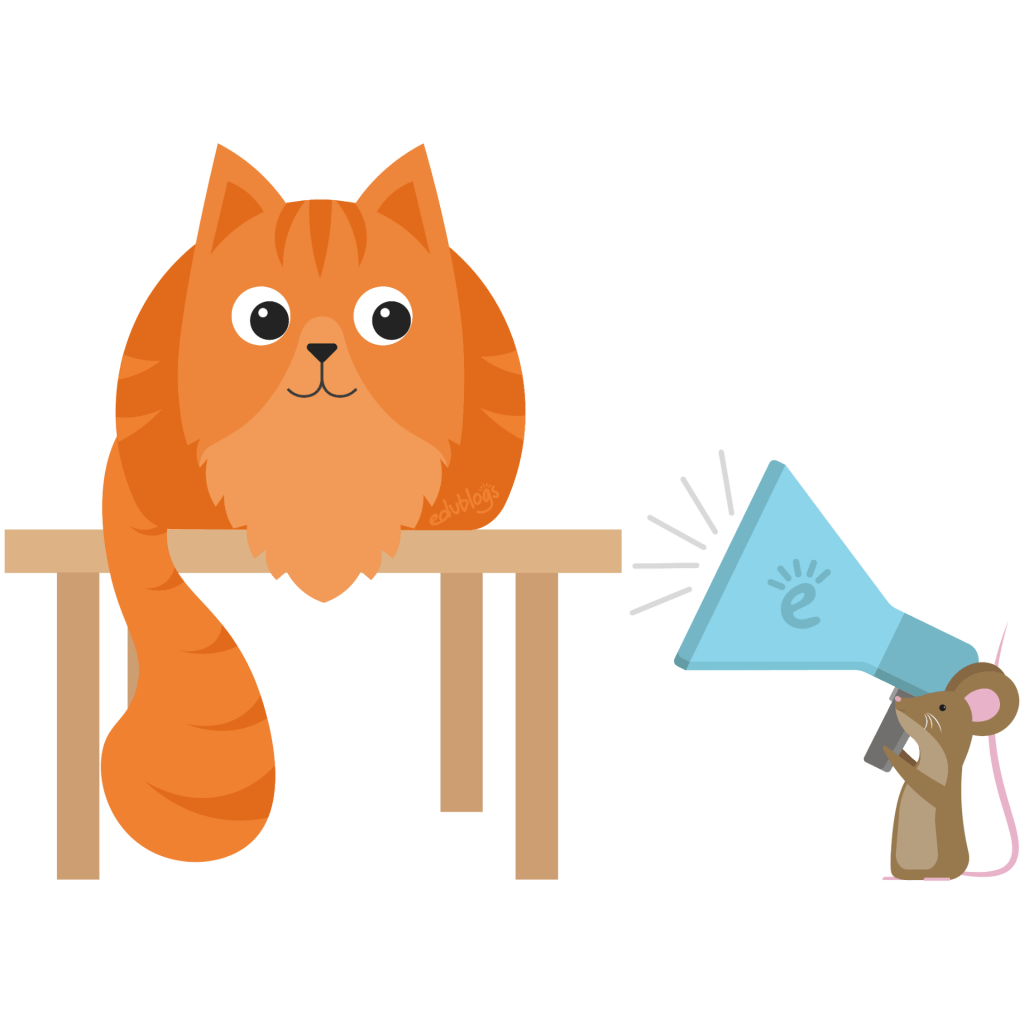
Conclusion
If you've made it this far into the guide you will take realized that copyright is a vast and circuitous topic, however, yous don't need to be an proficient to understand the nuts.
We've made a collection of slides which you're welcome to use in your ain classroom or mayhap you'd like to use them as function of your professional development program. Want to make a copy? Gyre down for instructions (don't request access).
Want a copy of the Google Slides presentation? Don't request access, just follow the steps below.
1) Click on this link: https://docs.google.com/presentation/d/1jK-_bTIBa9CZAC-bqKd0PQc7ohG9L47KSdcvfHgIxqw/re-create?usp=sharing
2) You will be prompted to make a re-create (screenshot below).
iii) The Slides will be saved in your Google Bulldoze.
4) You can edit the Google Slides to suit.
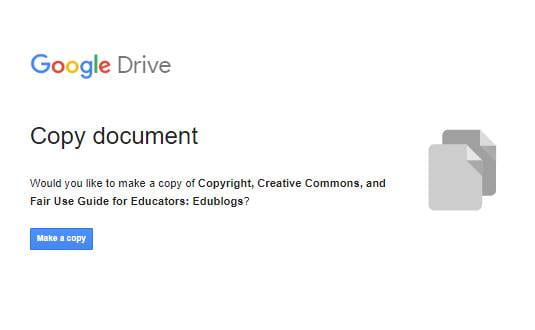
Before we conclude, have a moment to reflect back on the rules to remember about copyright.
- Just because you found it online, doesn't mean information technology's free to utilize (fifty-fifty if you're a teacher or educatee).
- There are a lot of resources you can use freely including work that has a Artistic Commons license or is in the public domain.
- Y'all have a correct as a creator to have your work protected from copying and you can too requite your own content a Creative Commons license.
- If in doubt about using content, inquire the creator for permission, find a gratuitous culling, buy an alternative, or make your ain material.
- Instead of looking for loopholes, consider whether you're being the near responsible and upstanding digital citizen yous can exist.
Do you accept any other tips to add about copyright for educators, students, or bloggers? Be certain to go out a annotate and let u.s. know. We'd love to hear your suggestions.
For any specific questions regarding your ain copyright dilemmas, please consult professional legal advice.
About Us
Edublogs is the oldest and about trusted spider web publishing platform for students and teachers around the globe. We have helped create and publish more than 5 one thousand thousand blogs, websites and portfolios since 2005 while providing teacher-friendly, student-safe WordPress solutions at calibration.
We offer both price-efficient and free options, forth with site development, hosting, security, plugin and theme back up to ensure your digital presence is meeting your goals in a fast-changing digital world.Want to larn more? Contact us to receive more than data.
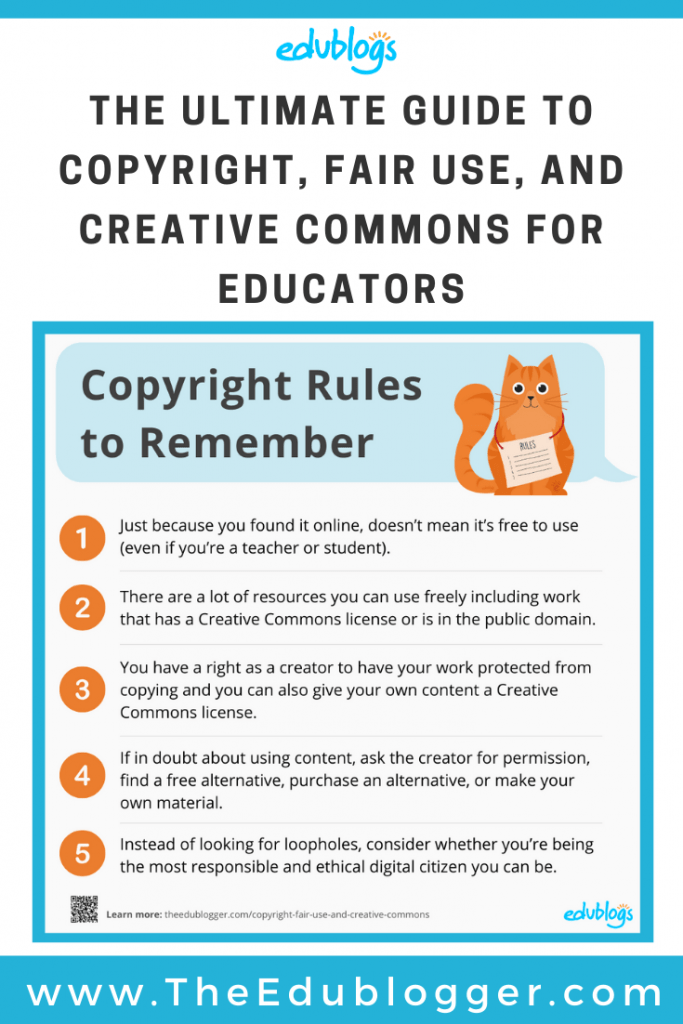
Source: https://www.theedublogger.com/copyright-fair-use-and-creative-commons/
0 Response to "Do I Upload Cover and Text Separately for Copyright"
Postar um comentário